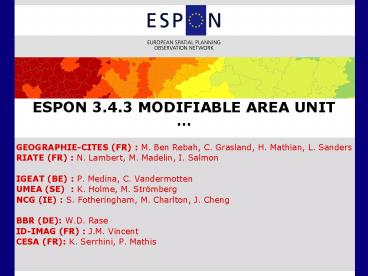ESPON 3'4'3 MODIFIABLE AREA UNIT PowerPoint PPT Presentation
1 / 43
Title: ESPON 3'4'3 MODIFIABLE AREA UNIT
1
ESPON 3.4.3 MODIFIABLE AREA UNIT
- GEOGRAPHIE-CITES (FR) M. Ben Rebah, C.
Grasland, H. Mathian, L. Sanders - RIATE (FR) N. Lambert, M. Madelin, I. Salmon
- IGEAT (BE) P. Medina, C. Vandermotten
- UMEA (SE) K. Holme, M. Strömberg
- NCG (IE) S. Fotheringham, M. Charlton, J. Cheng
- BBR (DE) W.D. Rase
- ID-IMAG (FR) J.M. Vincent
- CESA (FR) K. Serrhini, P. Mathis
2
PLAN
- Content of the final report
- 2. Modifiable Area Unit as Progress
- 3. NUTS 3 Units as Problem
- 4. Recommendations for ESPON II
3
CONTENT OF THE FINAL REPORT
- Part 1 Scientific approach of the MAUP
- What is the MAUP ?
- State of the art
- Case study on Sweden
- Case study on Ireland
- Case study on Germany
- Part 2 ESPON and the MAUP
- Examples of MAUP in ESPON
- Survey on cartography
- Part 3 Progress for ESPON II
- New statistical divisions
- Smoothing methods
- Cartograms
- Gridding methods
- Dynamic maps
4
PATH OF PROGRESS FOR ESPON II
Key message The fact that cartographical and
statistical results are changing with scale and
territorial divisions is a factor of progress for
reserarch. ESPON II has interest to develop a
wider set of solution for cartography and
statistical analysis than ESPON I.
5
Progress 1 combination of size and intensity
6
Progress 2 use of cartograms
7
Progress 2 use of cartograms
8
Progress 2 use of cartograms
9
Progress 2 use of cartograms
10
Progress 3 use of gridding methods
11
Progress 3 use of gridding methods
12
Progress 3 use of gridding methods
13
Progress 3 use of gridding methods
14
Progress 4 use of (correct) smoothing methods
Interpolation methods are not adapted to the
production of relevant smoothed maps Indeed, they
keep the spatial heterogeneity of the original
territorial units. Therefore, these methods
displays different results when applied to NUTS2
or NUTS3 units.
15
Progress 4 use of (correct) smoothing methods
Smoothing methods based on potential take into
account the uncertainty on the initial
information. They introduce a scale parameter
which make possible to adapt the degree of
smoothing Therefore, these methods converge to
the same results when a sufficient radius of
smoothing is applied to NUTS2 or NUTS3 units.
16
Progress 4 use of (correct) smoothing methods
17
Progress 5 use of new statistical methods
Correlations can be different according to the
size of territorial units. Measuring correlation
at different scales of territorial division is
very interesting as it indicate at which scale
the relation exists or not
Relation between GDP/Inh. - evolution of
population(at Nuts 0 level)
18
Progress 5 use of new statistical methods
For a given size of territorial units,
correlation are also different according to the
geographical area (non spatial stationarity) With
Geographically Weighted Regressionwe can
produce a set of localised regression models
Relation between GDP/Inh. - evolution of
population(Nuts3, bandwidth 250km)
19
PROBLEM FOR ESPON II THE USE OF NUTS3 UNITS
Key message From scientific point of view, the
NUTS 3 level is definitively not relevant for
cartographic and statistical analysis. It should
be used only for initial data collection. From
political point of view, the choice of NUTS 3 is
a symbol of the lack of progress in political
integration of European Union.
20
Spatial differences appears at different scales
and can be considered as waves of different
lengths
21
Territorial units are filters (high-, low-,
bandpass)
22
A good filter should not be heterogeneous !
23
A CONCRETE ILLUSTRATIONhttp//www.lightpollution.
it/dmsp/
- Light pollution is a good example of information
that can be measured with very high spatial
resolution (less than 1 km)
24
(No Transcript)
25
Local territorial filter
Territorial information
Initial information
26
(No Transcript)
27
Medium territorial filter
Territorial information
Initial information
28
(No Transcript)
29
Heterogeneous territorial filter
Territorial information
Initial information
30
(No Transcript)
31
This map does definitively not reflect the
opinion of the ESPON scientific community
This map does not necessary reflect the
opinion of the ESPON monitoring comity
32
Our colleagues from OECD does not respect NUTS
units ...
33
... and propose an alternative harmonisation of
levels ...
34
... with creation of new unofficial units
when necessary
35
We have done proposals in ESPON project 3.4.3
36
but you will not see this maps in the ESPON
Atlas
37
may be because they are not politically correct
38
May be because ESPON definitively like
heterogeneity !
39
HARMONISATION OF STATISTICS AND TERRITORIAL UNIT
AS POLITICAL SYMBOL ?
Conflict with traditional powers (States, )
Elaboration of new statistical data and
territorial units
Emerging new political power (Europ. Union)
F. Ratzel, 1897, Politische Geographie
Increasing autonomy for political actions
40
RECOMMENDATIONS FOR ESPON II (I) Broadband
spatial analysis
A database at local level, able to combine
Eurostat information (LAU1, LAU2) but also other
sources (Corine Land Cover, .). A database at
World level, based on the division in states with
long term time series. A database at regional
level with new territorial divisions (not NUTS3
!) and new data sources (not necessary Eurostat).
41
RECOMMENDATIONS FOR ESPON II (II) New
integrated tools
42
RECOMMENDATIONS FOR ESPON II (III) Further
research on map perceptions
43
RECOMMENDATIONS FOR ESPON II (IV) And a new
template for diaporamas !

